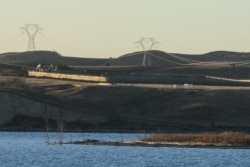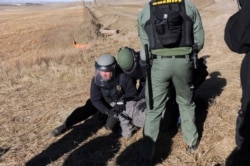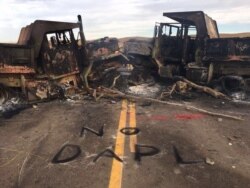The Standing Rock Sioux Tribe in North Dakota has requested a hearing on a planned expansion of the Dakota Access Pipeline, or DAPL. The tribe and its allies oppose the pipeline as culturally and environmentally catastrophic, and object to efforts by pipeline operator Energy Transfer Partners to boost horsepower, which would increase the current output of 500 million to 1.1 million barrels a day flowing from North Dakota’s Bakken oil fields to the Texas Gulf.
“We oppose the doubling of the capacity, as it will result in twice the damage in an already egregious trespass against the Oglala Sioux Tribe and all Lakota bands who signed the 1868 treaty with the United States,” said Chase Iron Eyes, lead counsel with the Lakota People’s Law Project.
In a June 19 letter to the North Dakota Public Service Commission (PSC), the attorney to Energy Transfer Partners, Lawrence Bender, announced the $40 million upgrade. He said it would “allow Dakota Access to meet the growing demand from shippers by optimizing and fully utilizing the existing pipeline infrastructure, without the need to install new pipelines, and without the need for shippers to use less safe and efficient means of transportation, such as rail.”
ETP wants to build additional pumping stations in North Dakota, South Dakota and Illinois. It is not yet clear what, if any, approval the company would need from state and federal regulators.
Looking back
ETP first announced plans to build the original pipeline in late 2014. The pipeline carries crude oil from the Bakken oil fields nearly 1,900 kilometers to holding tanks in Illinois, where it is then transported to refineries on the Texas Gulf coast.
Initially, ETP planned to route the pipeline beneath the Missouri River near North Dakota’s capital city, Bismarck. But the U.S. Army Corps of Engineers rejected the route as too long, too complex and a potential risk to Bismarck’s water supply.
Instead, ETP decided to route the pipeline beneath Missouri river at Lake Oahe, nearly a kilometer upstream from the tribe’s reservation boundary on land the 1868 Treaty of Fort Laramie designated as part of the Sioux territory which the tribe says it never ceded.
The decision sparked months of protests by Native American tribes, environmentalist and civil rights groups, which were marred by violence and multiple arrests.
Four days after he took the oath of office in January 2017, President Donald Trump signed an executive order allowing the U.S. Army Corps of Engineers to proceed with the project, and oil began flowing the following June. By law, the U.S. Army Corps of Engineers is responsible for evaluating and issuing permits for all water crossings.
‘Significant risks’
Jan Hasselman is an attorney with Earthjustice, a nonprofit environmental law organization. Hasselman, who represents the Standing Rock Tribe, believes pipeline operators must undergo a new permit evaluation, as the original permit was based on the pipeline’s existing capacity to carry oil.
“The Standing Rock Sioux Tribe has requested a (N.D. Public Service Commission) hearing and will be demanding that it undertake a thorough review of the significant risks created by the DAPL proposal,” said Hasselman in an emailed statement. “Remember that this is a proposal from one of the worst-run companies in the field, with an abysmal safety record.”
In January 2018, the Intercept news organization reported that the DAPL experienced five spills in 2017, the biggest of which leaked 636 liters into the soil in Patoka, Illinois.
The Standing Rock Tribe has also challenged the ETP’s ability to detect low level leaks and suggests that the environmental risk from DAPL is far greater than estimated by the Army Corps of Engineers study on the potential environmental impacts of the DAPL. The tribe also argues that current federal pipeline safety regulations are weak and inadequately enforced.
The ETP did not respond to VOA’s request for comment, but on its website says the DAPL was “built to be one of the safest pipelines in the world,” exceeding safety and environmental regulations. The energy group has also pledged to work closely with local, state and federal authorities during planned upgrades to make sure they remain in full compliance with all regulations and permit requirements.
The Public Service Commission has designated Aug. 9 as the deadline for hearing requests, but suggested that it may decide on the matter without a hearing.








